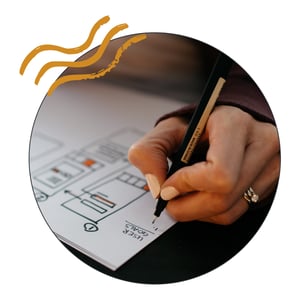BLOG What is Agile Software Development?
What is Agile Software Development?
POSTED BY Primitive | Apr 9, 2020

The word agile is an umbrella term that refers to the methodologies which engage in an iterative process. Thus Agile software development is incremental, a team-effort, and continually evolving as opposed to a process that aims to present all at once, and at the end.
In this article, we’ll explore the Agile methodology as it pertains to software development, along with a few of its pros and cons.
The Waterfall Method vs Agile
The Waterfall method is a strictly sequential design process that sees progress flow steadily through the phases: conception, initiation, analysis, design, construction, testing, production/implementation, and maintenance, much like a waterfall.
If provided everything necessary during pre-production, the Waterfall method stands to be an efficient, linear method to developing software. However, it is difficult to obtain every little detail all at once and prior to development, which means making changes is difficult. Thus, it is rare to have one phase begin when another has not been completed.
In light of these frustrations, the Agile software development method came to be.
The Agile Process (Lifecycle)
The goal within each project is to adapt to change and deliver a working, final product as soon as possible. However, even with this being the goal, it’s important to note each process is dictated by a specific set of requirements or situations.
Concept
This stage is the pre-project stage where collaboration with stakeholders is in abundance.
At this stage, a developer will define the business opportunity, identify the strategy (build or modify an existing product, for example), and assess whether or not it makes sense to invest in the product.
Inception
The goal within the inception stage is to initiate the project build.
In this stage, it is important to be able to: justify the feasibility of your project, work with stakeholders to identify the initial requirements, identify key team members, identify a starting architecture, create proper workstations, and take an initial estimate of how long the project will take based on the capacity of your team.
Iteration
The iteration stage allows Agile developers to begin incrementally slotting in high-quality, working software into the project. This stage is heavy in: collaboration, prioritizing and implementing functionality based on stakeholders’ needs and requirements, and lots and lots of testing.
Release
This stage is also known as the “end game” or deployment stage.
For many complex systems, the end game can result in multiple iterations. However, for the most part, this stage is when the final testing of the new product should occur. Many developers will continue to rework the product in this stage. Once defects are addressed, the developer can train the end user on the software, and then deploy it
Production
The production stage is meant to keep the product running smoothly and useful to the community post-deployment.
Retirement
The retirement stage is simple in concept but can be difficult in execution.
In this stage, the product is set to be released from production with as little impact to current processes and systems as possible. A few reasons as to why a project should be removed from production are if the system has proven obsolete, redundant, or no longer needed to support a business model.
Pros and Cons
Although adopting an Agile process sounds ideal, there are pros and cons associated with this type of methodology.
Let’s explore a few of each.
Pros
Change is embraced – Being flexible means adapting to change. A client can easily add, delete, or change priorities within each cycle which will guide the team, moving forward, on any following iterations.
Faster, high-quality delivery – The Agile process is focused on presenting working deliverables to clients, not necessarily perfect deliverables. This alone means products will arrive at market faster.
Clients are heard – When a team works closely with a client, they are able to revisit priorities, requirements, and expectations. Being in constant communication means the clients are often heard.
Cons
Poor behaviors can surface – Regardless of the methodology, it is difficult to succeed without some degree of tools, systems, and/or processes in place. If a team leans too far to the side of being Agile, and they in turn rely on someone with poor fundamental skills to lead, the team will undoubtedly encounter a trickle-down effect of poor behaviors that can infiltrate the team as a whole.
Internal processes – Even though Primitive sees the benefits of adopting an Agile methodology, it’s critical to understand whether or not your company is ready for a highly-flexible and iterative process. If a company typically abides by the laws of budget approvals, regular roadmaps and forecasting, adopting an Agile approach can prove to be quite the challenge.
Final product can be different than planned – Being flexible, while a pro of the Agile methodology, can also mean the predictability of a project is very difficult to come by. When requirements or priorities change, it can be hard to see where the project is heading.
Looking closely at different software development methodologies can help you and your business determine which processes align best with your company’s practices. Like stated earlier, the Agile method in software development is more than a specific framework or set of practices. To be successful with Agile, you must accept a flexible mindset that yields a flexible approach to your software’s development.
The Agile method of software development, although not the only method, is one that Primitive proudly adopts. By structuring our operations in a manner that proactively responds to change, we are better equipped, and able, to speak to the needs of our clients.
Visit our blog to learn more about software, today.
SHARE THIS POST:

About the writer, Primitive
The team behind On the Dot. is made up of creatives, strategists, and developers who give a damn. At Primitive, we craft digital solutions that help businesses grow from brand to backend. Every insight we share is backed by strategy, driven by results, and built to move your business forward.
